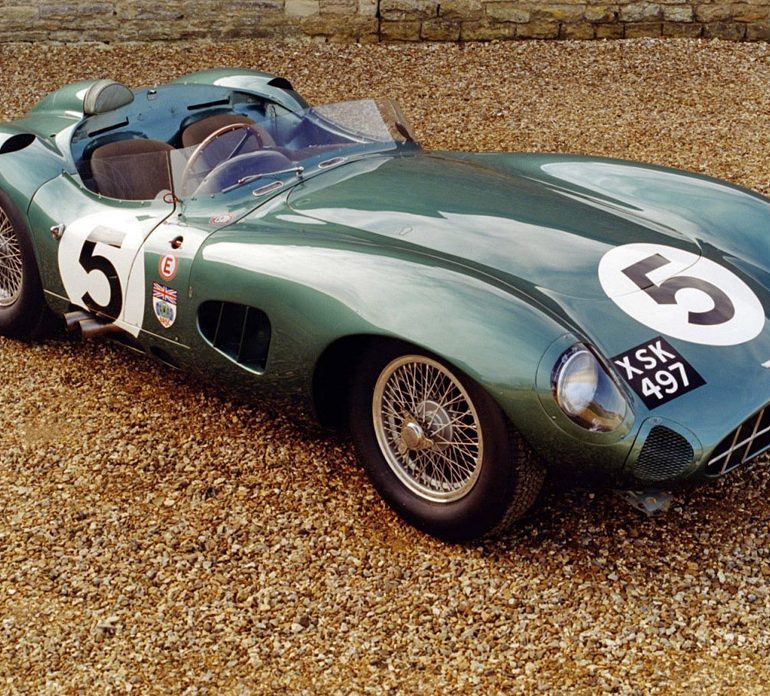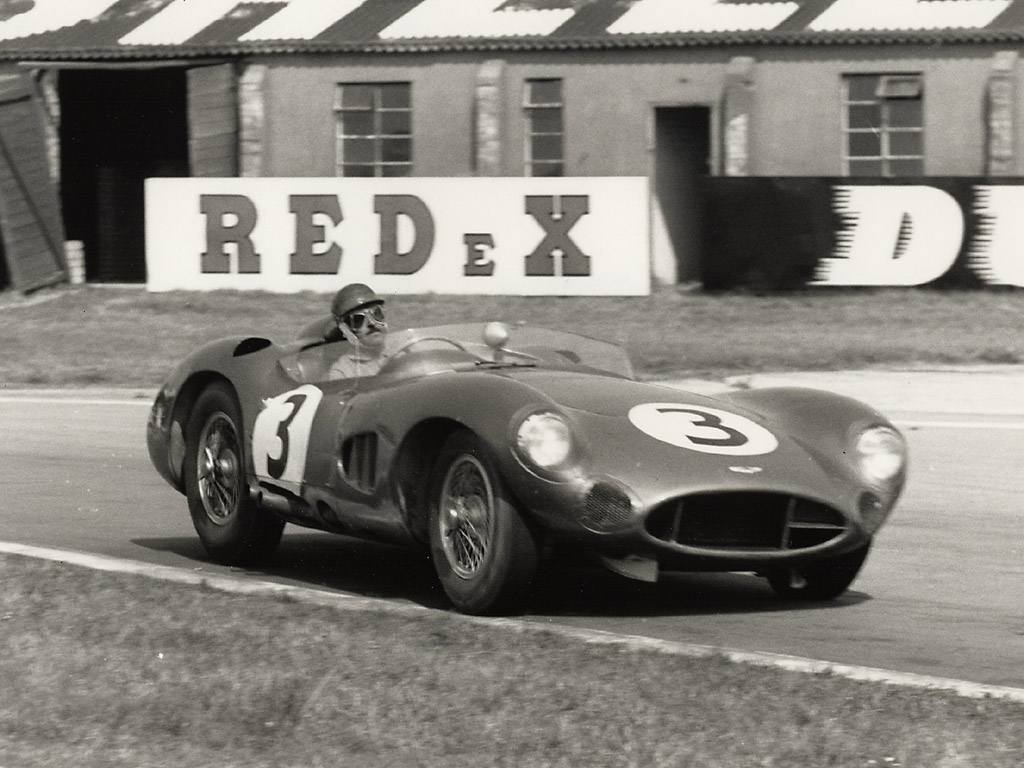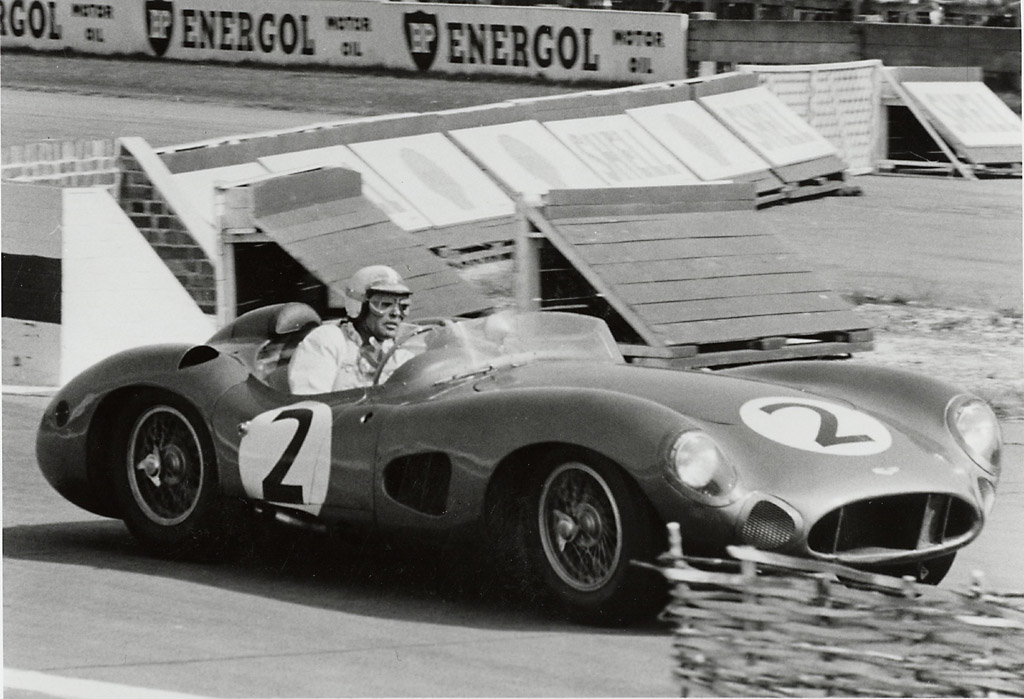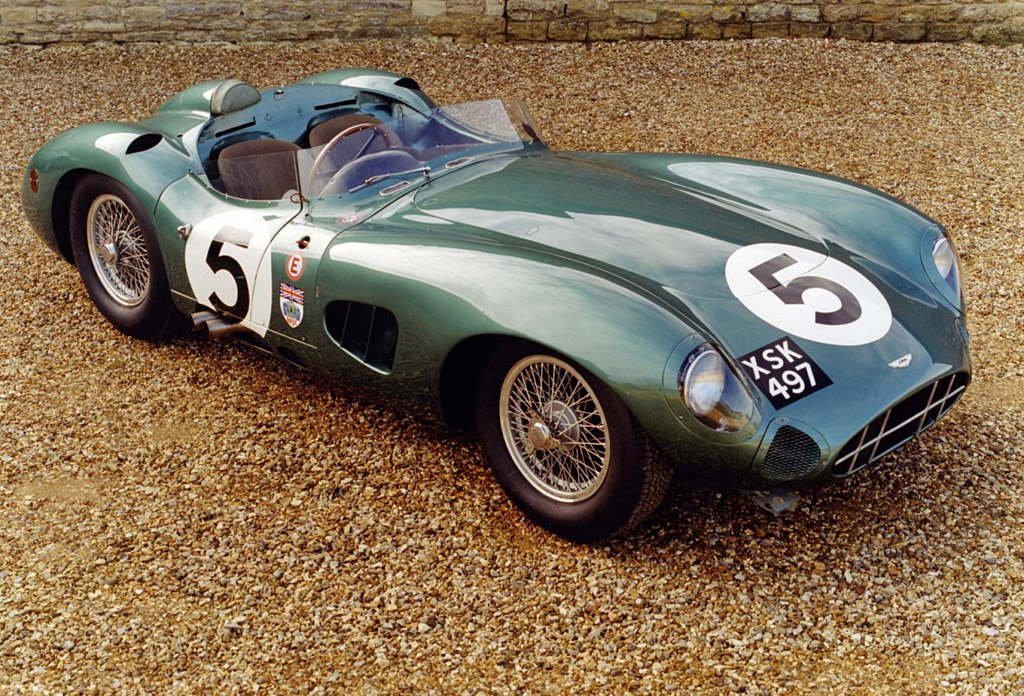1957 Aston Martin DBR1
Ten years after David Brown bought Aston Martin, he would finally achieve his racing ambitions and win the 24-Hours of LeMans. This high point in Aston’s history came when Carol Shelby and Roy Salvadori drove DBR1/2 to overall victory. Their car has now become the most valuable Aston Martin and is commonly seen racing with its ‘XSK 497’ registration.
The DBR1s benefited from ten years of development, including cars such as the DB1, DB2, DB3 and DB3S. All these helped the company achieve the necessary engineering, know-how and financial support to win LeMans. Like the DB3S, the DBR1 was a devoted race car that shared little with production Aston Martins. Its engine, space frame chassis and rear transaxle were all specially made.
Compared to the DB3S, the DBR1 was obviously a superior machine that was lighter and more powerful. Despite an increase in both wheelbase and track, the car managed to be 300 pounds lighter. Much of the weight savings came from a 20-gauge magnesium-alloy body which was vulnerable to damage both on and off the track. A new space frame chassis was drawn up by chief designer Ted Cutting that used the suspension and disc brakes from the DB3S.
Made for the first 2.5-liter formula after the tragic incident at the ’55 LeMans, the DBR1 was powered by a 2.5 liter version of the DOHC, six-cylinder engine. With twin-spark ignition and a light-weight aluminum block, around 220 bhp was available. This power was delivered to the rear wheels through a 5-speed transaxle, putting more weight on the rear wheels.
Aston Martin aimed to race the DBR1 at the 1956 LeMans, but this deadline proved to be too early. Tony Brooks and Reg Parnell piloted DBR1/1 but retired after 246 laps and 21 hours with gearbox failure. Ferrari and Maserati also dropped out of the race, leaving the privately entered Jaguar D-Types to take overall victory.
For the 1957 season, more talent was brought on board including John Wyer as general manager and Reg Parnell as racing manager. The year started out optimistically with a second place finish for Roy Salvadori at the British Empire Trophy and another second place at Goodwood’s Sussex Trophy. At this point DBR/1 was fitted with a larger 2922cc engine that could better complete with Ferrari 250s, Jaguar D-Types and Maserati’s V8-powered 450S. It was joined by DBR1/2 and both contested the SPA Grand Prix for Sportscars. They finished 1-2, with Tony Brooks taking the overall victory. At the 1000km of Nurburgring, Tony Brooks again won and gained Aston their first points in the World Sportscar Championship. The coveted LeMans ended in failure for both of Aston’s cars.
1958 was a mediocre year for Aston Martin. A three-liter limit on engine capacity eliminated Maserati, Jaguar and the Lister-Jaguars, but Ferrari’s Testa Rossas were still in full force. Gearbox failure retired many of the DBR1s during the season, including the 12 Hours of Sebring and Targa Florio. At the 1000km Nurburgring, Stirling Moss and Jack Brabham raced the new DBR1/3 and won. At LeMans, all three DBR1s failed to finish, and left Ferrari with victory just ahead of Aston Martin’s backup DB3S. The LeMans retirements were made up with a 1-2-3 at the Tourist Trophy which placed Aston second in the World Sportscar Championship behind Ferrari.
All the setbacks with the DBR1 and its unreliable gearbox were soon forgotten in the 1959 season. DBR1s were prepared almost exclusively for LeMans while the larger-engined DBR2 raced in non-championship events. Aston only entered the Nurburgring which was a safe bet and they won again for the third time in a row. This victory was one of Sir Stirling Moss’s greatest races, having to make up for expensive time lost with Jack Fairman behind the wheel. Before LeMans, 2992cc engines were fitted replacing the 2922cc units. In this configuration, Shelby and Salvadori drove DBR1/2 to victory at LeMans after the leading Ferrari retired. Finally, David Brown’s dream was realized and a World Sportscar victory seemed possible. The deciding race was Goodwood and Aston Martin entered three DBR1s. During the race, DBR1/3 went up in flames forcing Whitehead, who was privately racing DBR/5, to retire and offer his pitlane spot to the works team. To secure the championship, Shelby and Fairman had to take first place which they needfully did.
Upon winning the 1959 championship, David Brown announced Aston Martin’s withdrawal from the Sportscar Championship. After ten years, his ambitions were achieved and he planned to focus on new efforts like Grand Prix. In a speech he made to celebrate his championship win he stated, the sports-racing car of today has become a more complicated and expensive version of a Grand Prix car. He added, our own racing efforts in 1960 will be concentrated upon the Grand Prix field. This speech effectively ended a chapter of Aston Martin racing.
Story by Supercars.net
In Detail
| submitted by | Richard Owen |
| production | 5 |
| engine | Type RB6, Aluminum, Twin Spark, Inline-6 |
| position | Front Longitudinal |
| aspiration | Natural |
| valvetrain | DOHC, 2 Valves per Cyl |
| fuel feed | Tripple Weber 45DCO Carburetors |
| displacement | 2992 cc / 182.6 in³ |
| bore | 84 mm / 3.31 in |
| stroke | 90 mm / 3.54 in |
| compression | 9.3:1 |
| power | 179.0 kw / 254 bhp @ 6250 rpm |
| specific output | 84.89 bhp per litre |
| bhp/weight | 317.5 bhp per tonne |
| redline | RWD |
| body / frame | 20 Gauge Magnesium Alloy (0.03in) Body over Steel Tubular Space Frame |
| driven wheels | Front Engine / RWD |
| front brakes | Girling Discs |
| f brake size | x 318 mm / x 12.5 in |
| rear brakes | Girling Discs |
| r brake size | x 292 mm / x 11.5 in |
| steering | Rack & Pinion |
| f suspension | Trailing Links |
| r suspension | Revised DeDion-Type Axle w/Trialing Links, Watts Linkage |
| curb weight | 800 kg / 1764 lbs |
| wheelbase | 2286 mm / 90.0 in |
| front track | 1308 mm / 51.5 in |
| rear track | 1308 mm / 51.5 in |
| length | 4026 mm / 158.5 in |
| width | 1626 mm / 64.0 in |
| height | 978 mm / 38.5 in |
| transmission | CG537 CG537 5-Speed Transaxle |
| gear ratios | :1 |
| designers | Ted Cutting (body, chassis) |
| key drivers | Stirling Moss, Roy Salvadori, Carol Shelby, Tony Brooks |
| race victories | 1957 Nurburgring 1000km FOA, 1957 SPA Grand Prix for Sportscars FOA, 1958 Nurburgring 1000km FOA, 1958 Goodwood Tourist Trophy FOA, 1959 Nurburgring 1000km FOA, 1959 LeMans FOA, 1959 Goodwood Tourist Trophy FOA |







